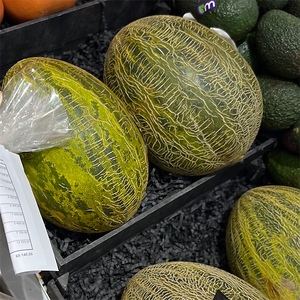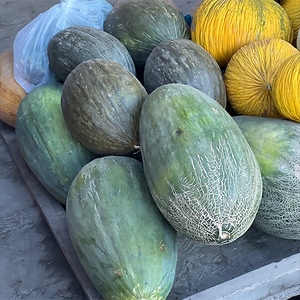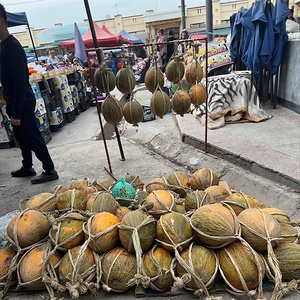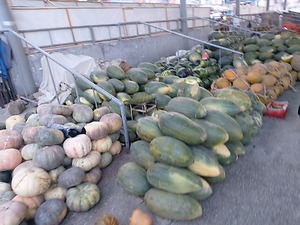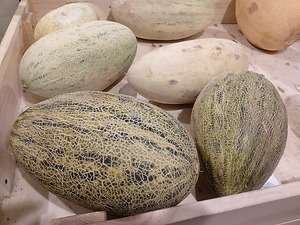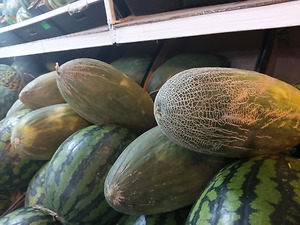


Green Gulyabi Melons
Estimated Inventory, lb : 0
Description/Taste
Green Gulyabi melon are medium-sized to very large fruits that have an elongated, oval shape with slight tapering towards one end. The rind is tough, fibrous, and smooth with a variegated striping of dark green and golden yellow hues. Underneath the rind, the flesh is dense, pale green-white, and aqueous with a soft, tender consistency, encasing a small central cavity filled with white membranes and light brown to cream-colored, oval seeds. Green Gulyabi melons are known for their aromatic qualities, which can be detected from a distance, and have a sweet, succulent flavor.
Seasons/Availability
Green Gulyabi melons are available in the fall through spring in Central Asia.
Current Facts
Green Gulyabi melon, botanically classified as Cucumis melo, are a sweet, autumn-winter variety that belongs to the Cucurbitaceae family. Also known as Chardzhou melons, there are four main varieties of Gulyabi melons that are native to hot, dry regions of Central Asia, all varying in size, shape, and appearance. The melons are known for their sweet flavor and have become one of the most in-demand melons in local Asian markets. Green Gulyabi melons have excellent storage capabilities and are commonly exported into Russia and Eastern Europe. The melons are primarily consumed fresh, out-of-hand to savor the juicy, soft flesh and sweet flavor, but they can also be used in a wide variety of culinary applications.
Nutritional Value
Green Gulyabi melons are a good source of vitamin C, potassium, and also contain some fiber, folate, vitamins B6 and K, and magnesium. In some traditional medicines, it is believed consuming the melon can help improve the skin and hair, reduce symptoms associated with high blood pressure, improve digestion, and increase fluid levels within the body.
Applications
Green Gulyabi melons are best suited for raw applications as its soft and juicy flesh and sweet flavor is showcased when consumed fresh, out-of-hand. The melon can be sliced in half, and the flesh scooped out with a spoon, sliced into wedges, or removed from the rind and cubed. When cut, the flesh can be added to fruit bowls, tossed into green salads, used as a topping over oatmeal, cereal, and porridge, or blended into juices, smoothies, and refreshing beverages. The melon can also be stirred into soups, cooked into compotes, jams, and jellies, dried for extended use, or used in baby food as the flesh easily breaks down in the digestive system. In addition to fresh and cooked applications, Green Gulyabi melons are commonly candied or baked into desserts such as pastries and pies. The seeds of the melon are also sometimes pressed into oil and are used for everyday cooking. Green Gulyabi melons pair well with vanilla, yogurt, honey, nuts, cucumbers, tomatoes, mushrooms, goji berries, mint, and crème fraiche. The fresh melons will keep 1-3 months when stored in a cool, dry, and dark place.
Ethnic/Cultural Info
In South Kazakhstan, many cities hold annual melon festivals in late August to celebrate the diversity of the varieties found through local regions. In the Turkestan province, the celebration known as Kauyn Fest includes over twenty-seven types of melons, and visitors can sample and even take home a melon. There are also games and competitions involving melons, consumer goods such as jams, dried fruits, and candied melons for sale, and live performances of entertainers dressed like melons. In addition to live entertainment, the festival holds an art exhibition featuring intricately carved melons and multi-level towers built out of the fruits. In Kyzylorda, the festival of watermelons and melons features flash mobs, food vendors, celebrity appearances, and an agricultural fair that showcases melons such as the Green Gulyabi.
Geography/History
Green Gulyabi melon are native to Central Asia and have been grown for hundreds of years, thriving in warm, dry climates. As cultivation increased, the melons were believed to have been introduced to Russia sometime during the 16th century and were brought to the United States for research purposes during the 19th century. Today Green Gulyabi melons are cultivated in Uzbekistan and are exported to countries in Eastern Europe and Russia. They are also found in Kazakhstan and other regions within Central Asia. The Green Gulyabi melons pictured in the photograph above were discovered at the Green Market in Almaty, Kazakhstan.



